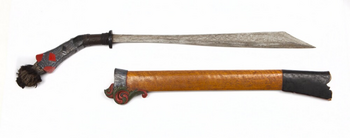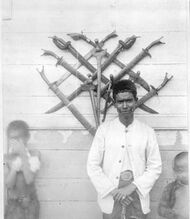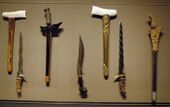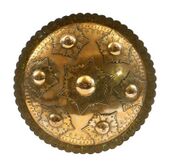Engineering:Klewang
| Klewang | |
|---|---|
 This sword with its blade from Buton, features a typical type of klewang, was obtained from South Kalimantan, pre-1890. | |
| Type | Cutlass, Sabre |
| Place of origin | Malay archipelago region[1] |
| Service history | |
| Wars | Aceh War (1873–1904) Indonesian National Revolution (1945-1949) |
| Specifications | |
| Length | 40–70 cm (16–28 in) |
| Blade type | Single edge, slight convex grind |
| Hilt type | Water buffalo horn, wood |
| Scabbard/sheath | Wood |
The klewang or kelewang is a category of traditional single-edged sword that can be found throughout the Malay archipelago region in Indonesia and Malaysia. Usually it is shorter than a pedang (sword) but longer than a golok (machete). There are straight bladed types, but most are curved.
History

During the Aceh War the Acehnese klewang proved very effective in close quarters combat against the sabre-wielding Dutch troops and the Royal Netherlands East Indies Army. Mobile troops armed with carbines and klewang succeeded in suppressing Aceh resistance where traditional infantry with rifle and bayonet had failed. The Dutch klewang was developed at the end of the 19th century, because firearms and also traditional swords were not always reliable at that time, especially in the jungle. 'A klewang in the right-hand fist never refuses', it was said.
From 1898 until the 1960s the Royal Dutch East Indies Army, Royal Dutch Army, Royal Dutch Navy and Dutch police used the militarised version of the klewang. These military versions were shortened sabres completely by European design, and better suited for close quarter fighting and jungle warfare. Officially the weapon was named the Marechaussee-sabre but the name klewang was more popular and later on also used as an official model.
Even from the time after Aceh was pacified by the Dutch to the 1930s and right through World War II, lone wolf Acehnese without generals would still attack Europeans in hopes of getting martyred themselves and attaining paradise. Weapons used in such cases were usually klewang, if not the Rencong.[2] The klewang was also used by the U.S. Army during World War II in the Pacific. [3]
Ceremonial use

In the Royal Netherlands Army the klewang is still used as a ceremonial weapon by the colour guard of the Regiment van Heutsz which took over the traditions of the Royal Netherlands East Indies Army, where the klewang was historically used as a side arm. The Royal Constibulary or Koninklijke Marechaussee and the Midshipmen of the Royal Dutch Navy also carries the Klewang in ceremonies and parades.
Description
The klewang features a single-edge blade with a protruding notch near its tip.[4] In size, weight and shape it is halfway between the golok and the kampilan. The style of the klewang differs between the various cultures of Indonesia. Blades range from 15 to 30 inches (38 to 76 cm) in length and may be straight or slightly curved.[5] It is carried for show by followers of chiefs, or taken on expeditions to market or nightly walks in the villages. It is worn without a sheath[6] although there are sheathed varieties.
In Malaysia, the klewang may be found in various states. The Kelantanese klewang features a curve blade with a spike, and was worn by men in the 19th century at the back of the sarong with the blade protruding.[7]
Geographical varieties
Aceh
- Amanremu
- Co Jang
- Ladieng
- Sikin Panyang
Sulawesi
Script error: No such module "overlay".
Timor
Script error: No such module "overlay".
Others
Script error: No such module "overlay".
See also
References
- ↑ Donn F. Draeger (2012). Weapons & Fighting Arts of Indonesia. Tuttle Publishing. p. 68. ISBN 9781462905096. https://books.google.com/books?id=1YbQAgAAQBAJ&q=Kris+golok+pedang+parang+Indonesian+weapons&pg=PA68.
- ↑ James T. Siegel (2011). Objects and Objections of Ethnography. Fordham Univ Press. p. 88. ISBN 978-08-232-3274-1.
- ↑ Puype, J.P. and Stürler Boekwijt, R.J. de (2001). Klewang, Catalogue of the Dutch Army Museum. Eburon. p. 68. ISBN 90-5166-836-8.
- ↑ Weapons and fighting arts of Indonesia, Donn F. Draeger, Tuttle Publishing, Apr 15, 1992 p.33
- ↑ Albert G Van Zonneveld (2002). Traditional Weapons of the Indonesian Archipelago. Koninklyk Instituut Voor Taal Land. ISBN 90-5450-004-2.
- ↑ Christian Snouck Hurgronje (1901). The Acehnese, Volume 1. Book On Demand.
- ↑ Farish Noor & Eddin Khoo (2012). Spirit of Wood: The Art of Malay Woodcarving. Tuttle Publishing. ISBN 978-14-629-0677-2. https://books.google.com/books?id=bIjQAgAAQBAJ&pg=PT195.
External links
- "Het ontstaan van de militaire Klewang (in Dutch)". Armamentaria/Dutch Army Museum. 2008. http://www.collectie.legermuseum.nl/sites/strategion/contents/i004543/arma09%20het%20ontstaan%20van%20de%20militaire%20klewang.pdf.
 |




